#philip saville
Text

The brides of Dracula from Count Dracula (BBC-TV, 1977)
103 notes
·
View notes
Text

Christian Bale as Chris in Metroland (1997) dir. Philip Saville
#metroland#chris#christian bale#actor#film#movies#hollywood#drama#icon#celeb#Philip saville#1997#1990s#1990s movies#1990s films#1990s icons#1990s actors#1990s hollywood#christianbalefanatic
25 notes
·
View notes
Text
"THE BUCCANEERS" (1995) Review
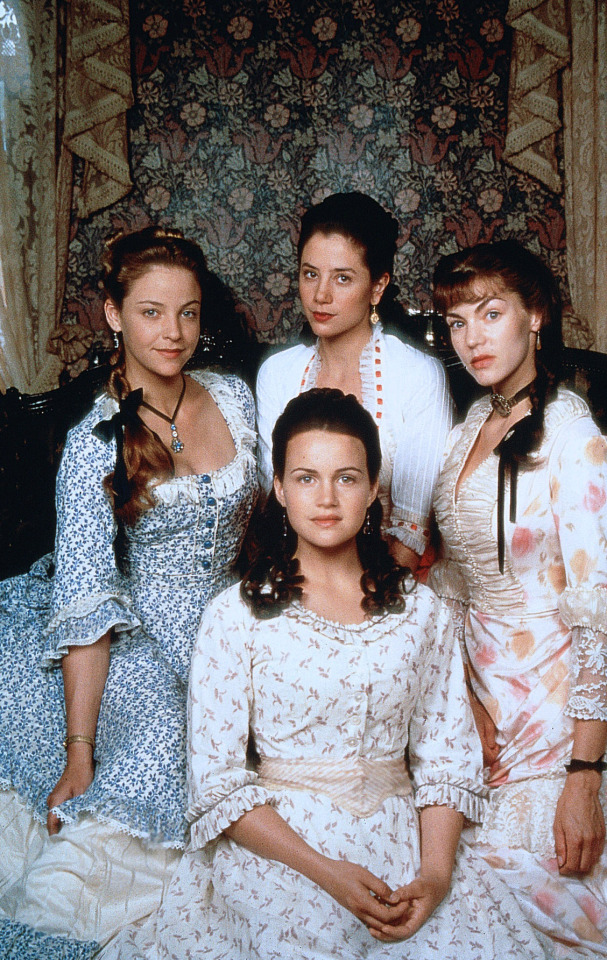
"THE BUCCANEERS" (1995) Review
Years ago, I had anticipating watching for the first time, "THE BUCCANEERS", the 1995 television adaptation of Edith Wharton’s last novel. After all, I have been a major fan of "THE AGE OF INNOCENCE", Martin Scorcese’s 1993 adaptation of Wharton’s award-winning 1920 novel for years. But my eager anticipating nearly ebbed away, when I discovered that "THE BUCCANEERS" only managed to rouse a lukewarm reception from many television critics.
The five-part miniseries turned out to be an unusual production from the BBC. One, it was based upon a novel written by an American author – namely Edith Wharton. There have been other British television productions based upon the literary works of an American, but they are very rare. Another interesting aspect of Wharton’s "The Age of Innocence" is that the author did not finish it, due to her death at the age of 75. Fifty-six years later, Wharton scholar Marion Mainwaring finished the novel, which was published by Viking. Around the same time, the BBC hired screenwriter Maggie Wadey to adapt and finish the novel for the television adaptation. As a result the novel has two slightly different endings. Another aspect of this miniseries that struck me as unusual was that instead of hiring British actresses to portray four of the five leads, the BBC hired four Amercian actresses – Carla Gugino, Mira Sorvino, Alison Elliott and Rya Kihlstedt.
The plotline for "THE BUCCANEERS" is very simple. The story begins in 1873 Newport, Rhode Island; in which two sisters of a noveau riche businessman and their two friends are introduced – Virginia "Ginny" and Annabel "Nan" St. George, Conchita "Connie" Closson and Elizabeth "Lizzy" Elmsworth. Whereas the Brazilian born Conchita manages to snare Lord Richard Marabel, the dissolute second son of the Marquess of Brightlingsea, the other three girls struggle to find a place amongst the members of old New York society. When a prank committed by Ginny and Lizzy backfires, Nan’s English governess Laura Testvalley proposes to Mrs. St. George that Ginny and Nan have a London season amongst the upper-class British. She argues that their acceptance by the British high society would assure them a place amongst the upper-class New Yorkers. Due to their friendship with the vibrant Conchita, Virginia and Annabel are introduced to Lord Richard’s family – the impoverished Brightlingseas and their neighbors, the equally impoverished Sir Helmsey Thwaite and his son Guy. As they get settled to conquer British society, Ginny and Nan are surprised by the arrival of Lizzy, who has arrived in Britain for her own season.
Although the girls’ original purpose for visiting Britain was to enjoy a London season, a friend of Laura Testvalley has other plans for them. Thirty years earlier, the American born Jackie March had been engaged to a British aristocrat – namely the very young Lord Brightlingsea, who abandoned her at the altar. Miss March remained in Britain and became something of a sponsor/matchmaker for young society girls. It was Miss March who recommended that the visiting Americans rent a villa owned by one of her former sponsors, Lady Idina Hutton. She also recommended that the girls do more than just enjoy a London season in order to impress old New York society. She recommended that they consider marrying into upper-class British society. Miss March’s plans eventually come to fruition:
*Virginia or namely her father’s wealth attracted the attention of Lady Idina Hutton’s lover and Lord Richard’s older brother, Lord Seadown.
*Lizzy ended up marrying a self-made aspiring politician named Hector Robinson
*Annabel fell in love with Guy Thwaite, but ended up marrying the very wealthy Julian Folyat, Duke of Trevennick; when Guy left Britain to find his fortune in South America.
As I had stated earlier, most critics were not initially kind to "THE BUCCANEERS". Most British critics dismissed it as a costumed soap opera of the second-rate kind, with an ending that had been "Hollywoodized" (happy ending). These same critics also accused the miniseries of mocking the British aristocracy. The American critics, at least those who considered themselves Wharton purists, accused the miniseries’ screenwriter, Maggie Waddey, of changing the elements of the author’s story by including topics such as marital rape and homosexuality. Personally, I found all of these arguments irrelevant. Most dramas about personal lives – whether first-rate or not – tend to possess soap-operish elements. This hostility toward soap operas has always struck me as infantile and irrelevant. And why are all Hollywood productions guilty of having a happy ending, when that has not been the case? Other literary works and their adaptations have mocked the British aristocracy. Why was there such a big hullabaloo over how the aristocracy was portrayed in this particular story? As for the additions of marital rape and homosexuality, these elements did no harm to the story, as far as I am concerned. And I must admit that I have become increasingly weary of demands that all movie or television adaptations should be completely faithful to their literary source. Such demands strike me as impractical.
My complaints about "THE BUCCANEERS" are very few. In fact, I only have two. The first time I ever saw actress Gwen Humble on the television screen was in a miniseries called "THE REBELS", an adaptation of a John Jakes novel. Although I had no problems with her performance in that particular production, I must admit that I had a problem with her performance as Virginia and Annabel’s mother, Mrs. St. George. I understand that Mrs. St. George was supposed to be a shallow and somewhat silly woman. But I feel that Humble went a little too far in conveying those certain traits. Her performance struck me as exaggerated and a little amateurish. Another problem I had with "THE BUCCANEERS" is a rather minor one. It has to do with Virginia’s husband, Lord Seadown. His father is a marquess – which is ranked somewhere between a duke and an earl (count). As the eldest son, he is entitled to a courtesy title. But what was Seadown’s courtesy title? His younger brother was called Lord Richard Marable, which is correct for the younger son of a marquess. The courtesy title for the eldest son of a marquess is usually an earldom – namely Earl of Something. Was Seadown’s name a courtesy title - Earl of Seadown? Or was he supposed to be regarded as Lord Seadown Marable? If the latter, what was the courtesy title he used? I found it all slightly confusing.
However, "THE BUCCANEERS" has been one of my all time favorite miniseries, ever since I first saw it. And there is so much about it that has made it such a favorite of mine. One, producer-director Philip hired a production crew that did justice to Wharton’s story. The miniseries featured some elegant locations that served as the story’s various settings. Some of these locations included Castle Howard, Burghley House and Newport, Rhode Island. I also enjoyed Remi Adefarasin’s photography. It had a deep and rich color that did justice to a story filled with emotions and passion. Colin Towns provided an elegant and entertaining score that remained memorable for me, since the first time I heard it years ago. But it was Rosalind Ebbutt’s costumes that really blew my mind. She provided exquisitely outfits that were beautiful and elegant – especially those for the lead actresses. More importantly, her costumes not only reflected the fashions wore by the American and British upper-classes during the 1870s, they also reflected the change in the main characters’ status and in women’s fashion throughout the decade, as the following photographs show:


Another one of the major virtues of "THE BUCCANEERS" turned out to be its cast. Wharton’s novel is filled with interesting characters. And Saville and his casting director did an excellent job in finding the right actor/actress for the right role. Aside from Gwen Humble’s portrayal of Mrs. St. George, there were so many first-rate performances in the miniseries that it would take me another article just to describe them. But the supporting performances that stood out for me came from the likes of Sheila Hancock, whose portrayal of the Dowager Duchess of Trevenick struck me as an expert mixture of cool haughtiness, sharp wisdom and long suffering; Michael Kitchen, who skillfully conveyed both the charming and shallow nature of Sir Helmsley Thwaite; Jenny Agutter, who was excellent as Lady Idina Hatton, Lord Seadown’s insecure and tragic mistress; Dinsdale Landen and Rosemary Leach, who both portrayed the Marquess and Marchioness of Brightlingsea with a mixture of class haughtiness, charm and great humor; Peter M. Goetz, who seemed to personify the self-made 19th century American businessman; and Connie Booth, who gave one of her best performances as the ambitious and sharp-minded Jackie March.
Richard Huw gave a humorous, yet intelligent performance as Hector Robinson, the ambitious young Member of Parliament who ends up winning Lizzy Elmsworth’s hand. And Mark Tandy was pretty solid as Lord Brightlingsea’s heir, the mercenary Lord Seadown who marries Virginia for Colonel St. George’s money. I was very impressed by Ronan Vibert’s portrayal of the dissolute Lord Richard Marabel, Conchita’s husband and Lord Brightlingsea’s younger son. But the two male performances that really impressed me came from Greg Wise and James Frain. The latter portrayed the haughty Julian Duke of Trevenick, who manages to win the hand Annabel St. George (much to the surprise of her governess), before alienating her with his lack of skills as a husband. Frain could have easily portrayed Julian as a one-note villain, especially when one considers the act of marital rape that his character committed against his wife in Episode Three. Being the skillful actor that he is, Frain conveyed all facets of Julian’s personality – both the good and the bad. And his assertion near the end of Episode Four that he is "not a monster" may have been one of Frain’s finest moments on screen. Greg Wise probably gave one of what I consider to be three of his best career performances in his portrayal of Guy Thwaite, Sir Helmsley’s only son. His Guy could have been one of your typical handsome, romantic heroes. But Wise did an excellent job in revealing how Guy’s insecurities regarding his lack of funds led him to lose Annabel to Julian. And he also conveyed how in the throes of love, Guy could be a slightly selfish man with no thought to how his "friendship" with Annabel might affect her social standing. Thanks to Wise’s performance, his Guy Thwaite proved to be equally complex.
We finally come to our five leads in the story – the four American heiresses and Annabel St. George’s English governess, Laura Testvalley. I have noticed that whenever someone brings up Cheri Lunghi, he or she inevitable brings up her role in "THE BUCCANEERS", the Anglo-Italian governess Miss Testvalley. I certainly cannot blame them. Lunghi proved to be the glue that held the story together, skillfully serving as its eyes and narrator at the beginning of each episode. Rya Kihlstedt gave a charming and solid performance as the blunt and level-headed Lizzy Elmsworth, who seemed more impressed by Hector Robinson’s ambitions than any aristocrat. She and Richard Huw managed to create a very credible screen presence. Alison Elliott’s Virginia St. George proved to be one of the most complicated characters in the story. Thanks to the actress’ excellent performance, she conveyed Virginia’s haughtiness and obsession with being connected to an aristocratic family; and at the same time, garnered sympathy by expressing the character’s love for her husband and disappointment upon discovering that he had only married her for money. And less than a year before she won her Academy Award, Mira Sorvino proved just how first-rate she could be as an actress in her portrayal of the Brazilian-born Conchita Closson. Her Conchita was a delicious and complicated minx torn by her desire for the luxurious and glamorous lifestyle of the British aristocracy and her contempt for what she deemed as their cold personalities. If Cheri Lunghi’s Laura Testvalley was the story’s eyes and narrator, Carla Gugino’s Annabel St. George aka the Duchess of Trevenick proved to be the heart and soul of "THE BUCCANEERS". Thanks to Gugino’s superb performance, the actress literally transformed Nan from the childish and naïve sixteen year-old girl, to the bewildered nineteen year-old bride and finally to the weary twenty-one year-old wife, disappointed by a failed marriage and in love with another man. There are times that I wondered if any other actress could have accomplished what she did. It seemed a pity that none of the major television and critics awards organizations never acknowledged her performance with a nomination.
Many critics have heaped a great deal of scorn upon Maggie Wadey’s adaptation of Wharton’s novel. Frankly, I believe this scorn was undeserved. I may not have been that impressed by her other works, but I honestly believe that "THE BUCCANEERS" was her masterpiece by far. Many accused her of failing to adapt Wharton’s "spirit" or "style" by including marital rape and homosexuality into the story. Since both topics where added without any tasteless sensationalism, I had no problems with these additions. And Wadey also made sure to give the story’s happy ending something of a bittersweet edge. Despite leaving Julian for the man she loved, Guy Thwaite, Annabel found herself ostracized by society and especially by her sister Virginia – as was proven at the Marquess of Brightlingsea’s funeral. Annabel and Guy’s elopement also left the latter disinherited by his father, Sir Helmsley. And her assistance in the elopement left Laura Testvalley rejected by Sir Helmsley and unemployed. So much for the "happy ending". Because the story revolved around four American heiresses marrying into the British upper-classes, "THE BUCCANEERS" also proved to be an interesting study in culture clash between two Western nations in the mid-to-late nineteenth century. But in all of the articles I have read about the miniseries, I find it surprising that no one has bothered to noticed that the topic of the continuing decline of the British aristocracy was also mentioned . . . more than once. It almost became a secondary theme. The Brightlingseas’ interest in the St. George family certainly seemed an indication that they were more willing to marry money – regardless from where it came – rather than find a way to earn it. This seemed like a far cry from Guy Thwaite, who preferred to create his own wealth with two years in South America, rather than marry it. And the character of the Marquess of Brightlingsea literally became a symbol of the aristocracy’s decline in scenes like a heated conversation between him and Hector Robinson; and a speech by Guy Thwaite to the House of Commons during a montage that featured of his death.
Now that I think about it, why should I care what others feel about "THE BUCCANEERS"? Every time I watch it, I always fall in love with the miniseries over and over again. Maggie Wadey wrote an excellent adaptation of Wharton’s novel – probably her best work or masterpiece, as far as I am concerned. Led by the likes of Carla Gugino, Cheri Lunghi, Greg Wise and James Frain, the cast proved to be first-rate. And Philip Saville did justice to both the cast and Wadey’s screenplay in his direction of the miniseries.

#edith wharton#edith wharton's the buccaneers#the buccaneers#the buccaneers 1995#maggie wadey#philip saville#carla gugino#cheri lunghi#greg wise#james frain#alison elliott#mira sorvino#rya kihlstedt#mark tandy#ronan vibert#richard huw#dinsdale landen#rosemary leach#gwen humble#peter michael goetz#conchata ferrell#michael kitchen#elizabeth ashley#james rebhorn#sheila hancock#jenny agutter#gilded age#victorian age#emily hamilton#connie booth
13 notes
·
View notes
Text














the buccaneers episode 1 "invasion" (1995) dir. philip saville
2 notes
·
View notes
Text

Dany Robin-David Hemmings "La mejor casa de... Londres" (The best house in London) 1969, de Philip Saville.
5 notes
·
View notes
Text

Joanna Pettet and David Hemmings in The Best House in London (Philip Saville, 1969)
Cast: David Hemmings, Joanna Pettet, George Sanders, Dany Robin, Warren Mitchell, John Bird, William Rushton, Bill Fraser, Maurice Denham, Wolfe Morris, Martita Hunt, Marie Rogers. Screenplay: Dennis Norden. Cinematography: Alex Thomson. Production design: Wilfred Singleton. Film editing: Peter Tanner. Music: Mischa Spoliansky.
Is there anything worse than a sex comedy that's neither sexy nor funny? Well, maybe a sex comedy predicated in part on the toxically masculine idea that sex workers choose their occupation because of the sex and not because they need work -- in short, that any woman would become a prostitute if it just meant having a lot of sex all the time. Philip Saville's The Best House in London endorses that notion. Joanna Pettet plays Josephine Pacefoot, a character based on, or rather parodying, the real-life Josephine Butler, a 19th-century English social reformer who, in addition to campaigning for women's rights, sought an end to human trafficking. In the movie, her campaign is ridiculed: The women she's trying to take off the streets and tech marketable skills are recalcitrant, constantly slipping back into prostitution as easier, more lucrative, and from the film's point of view more fun, with the result that the streets of Victorian London are crowded with hookers. This plays into the schemes of Walter Leybourne (David Hemmings), who persuades the British Home Secretary (John Bird) to allow him to establish an opulent bordello that will cater to the cream of English society and thereby ease the street traffic. The brothel is an enormous success and thereby becomes a target for Pacefoot's campaign, in which she is aided by Benjamin Oakes (also Hemmings), who is serving as a sort of publicist for her cause. The inevitable clash between the brothel and the reformer, and between the two characters played by Hemmings, forms the main plot. But that story is overlaid with subplots, one about the secret parentage of Leybourne and Oakes -- the justification for the double casting of Hemmings is that they are secretly half brothers -- and another, almost unrelated to the rest of the film, about Leybourne's assisting a pioneering aeronaut, Count Pandolfo (Warren Mitchell), in the construction of a giant dirigible. Meanwhile, the film is littered with cameo appearances of eminent Victorians: Dickens, Tennyson, Swinburne, Elizabeth Barrett, Darwin, Oscar Wilde, Lord Alfred Douglas, and fictional ones like Sherlock Holmes and Dr. Watson. (One of the few successful jokes in the film comes as invitations to the brothel opening are being sent out; when Dr. Jekyll's name comes up, someone says they'd better send him two.) The movie is cavalier about chronology: It doesn't seem to matter, for example, that Lord Alfred Douglas was born in 1870, the year that Dickens died. Still, the messiness of the plotting and insouciance about history matter less in the end than the fact that most of the comedy falls flat, the sex is of the nudge-nudge, wink-wink order, and the underlying premise of the film is distasteful.
6 notes
·
View notes
Text

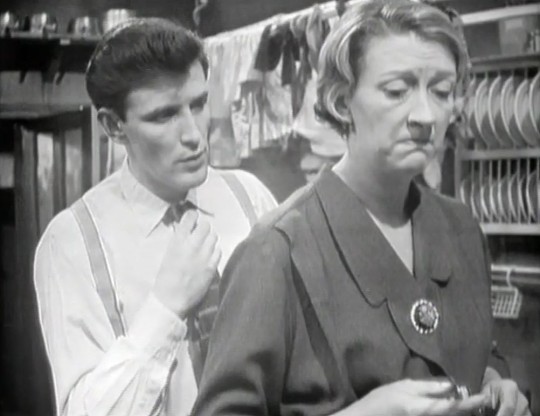
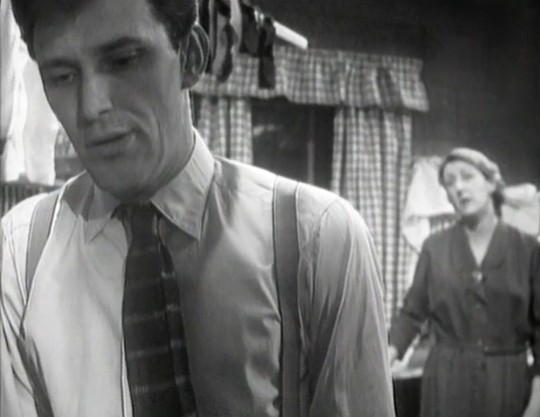
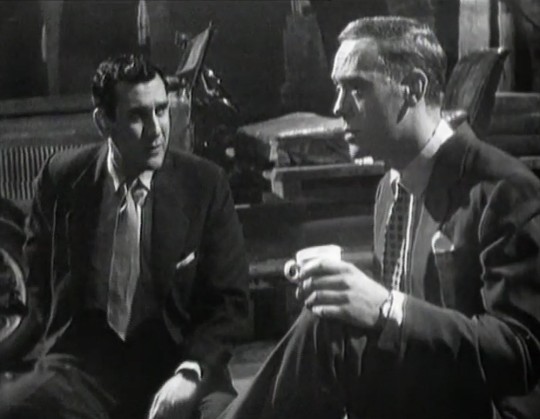

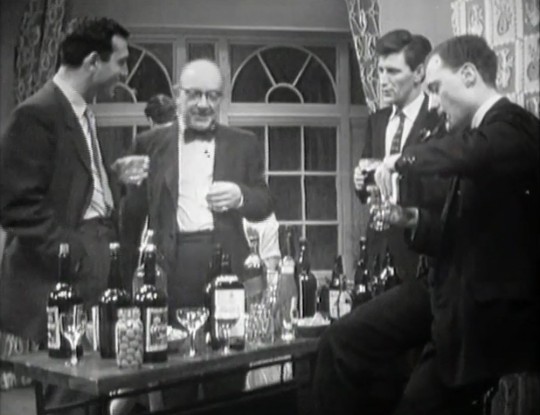

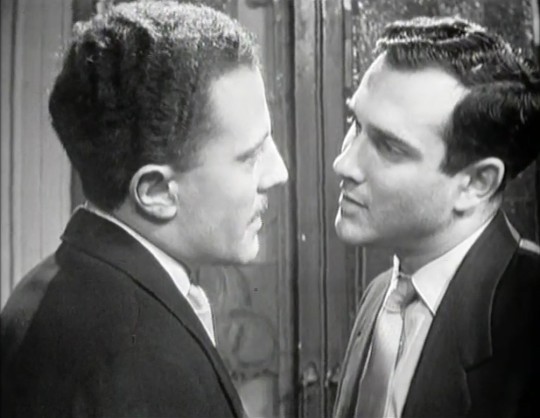
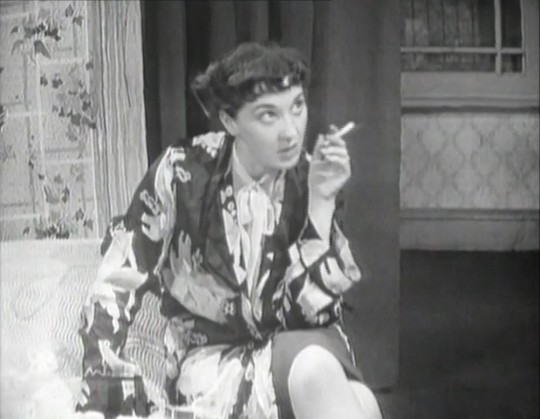

Armchair Theatre - A Night Out (1960) dir. Philip Saville, writer. Harold Pinter
Starring: Tom Bell, Made Ryan, Harold Pinter, Philip Locke, Stanley Meadows, Arthur Lowe, Vivien Merchant
#armchair theatre#a night out#1960#harold pinter#philip saville#tom bell#stanley meadows#madge ryan#arthur lowe#vivien merchant#philip locke#screencaps#screengrabs#my edits
0 notes
Text
The way The Thick of It jokes about Hugh Abbot (Chris Langham), Huw Edwards and Philip Schofield and I, here in 2024, sit knowing things they do not
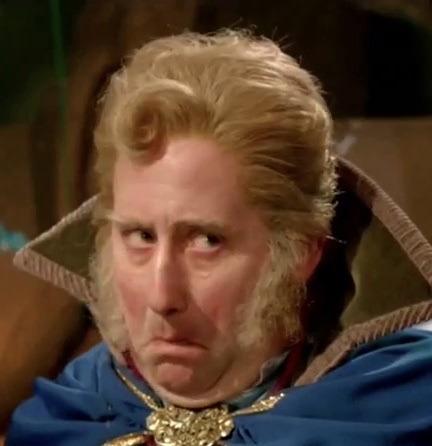
#for context all three men have been accused of paedophilia to varying degrees#chris langham was arrested and imprisoned but has since been released#(for possession of images of children AND having an inappropriate relationship with a teenager)#huw edwards and philip schofield have been accused of having inappropriate relations with teenagers#pretty sure they also joke about savile but I think that’s after people knew about junk#*him not junk#my own post#ttoi#the thick of it#this makes it sound like ttoi jokes about paedophilia a lot which they don’t - the ‘jokes’ I mentioned are literally just one off lines#they only stood out to me because of the recent news about edwards & schofield and knowing about langham when I didn’t last time
8 notes
·
View notes
Text








Ray Davies in The Long Distance Piano Player (1970), written by Alan Sharp, dir. Philip Saville
#raymond ❤️#✨A M A Z I N G✨ actor#OUGH he is simply breathtakingly gorgeous in this film#he’s exquisite#talented musician AND actor. i love the fact that he’s into two things that bring joy to my heart: music and film#the long distance piano player#ray davies#my gifs
79 notes
·
View notes
Text

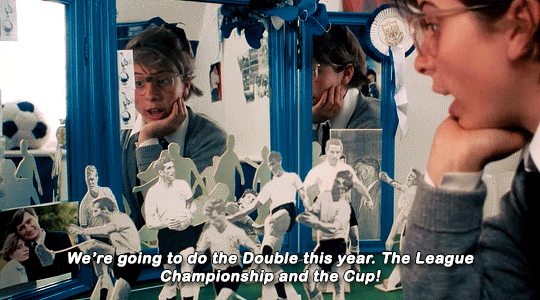

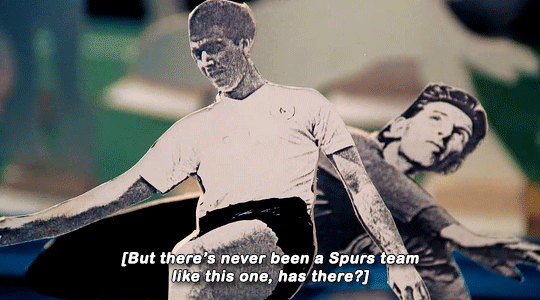

Supple and imaginative, that's how the game has to be played at Spurs! Years from now, they'll talk of you. They'll say your names in pubs. They'll say: "That's the team that did the Double." You see the little old lady over there? She remembers it happening.
THOSE GLORY GLORY DAYS
1983, dir. Philip Saville
written by Julie Welch
#those glory glory days#filmedit#filmgifs#tottenham#tottenham hotspur#spurs#football#julie welch#this film is the ultimate comfort film i smile and cry and laugh watching it. all about girls who love spurs in that infamous 60/61 season#the mc is soooo endearing w her obsession w danny blanchflower and her figurines <3#just brilliant man when i had nothing i had this film fr!#it's on youtube i can send anyone who's interested a link but you can find it rly easily by googling#for every spurs fan but esp for laura since she loves this film <3#rahul.gif
13 notes
·
View notes
Text



Louis Jourdan, as Dracula, in Count Dracula (BBC-TV, 1977)
97 notes
·
View notes
Text
(Mostly) Lost, but Not Forgotten: A Thief in Paradise (1925)




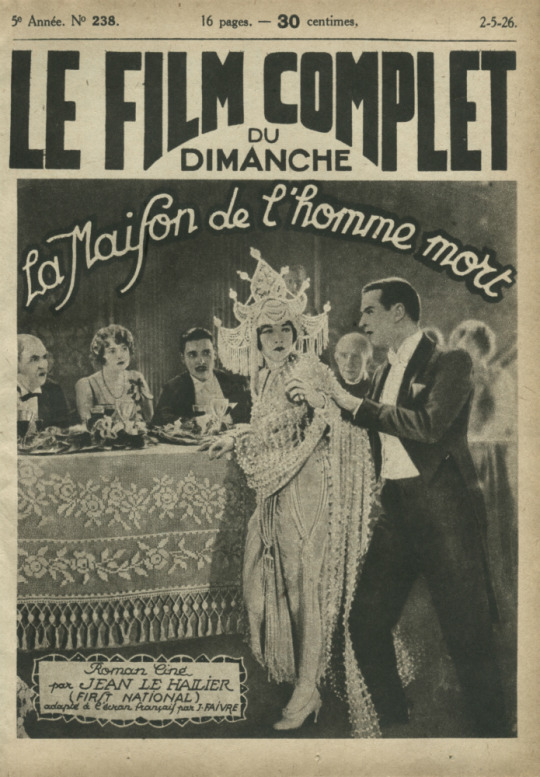
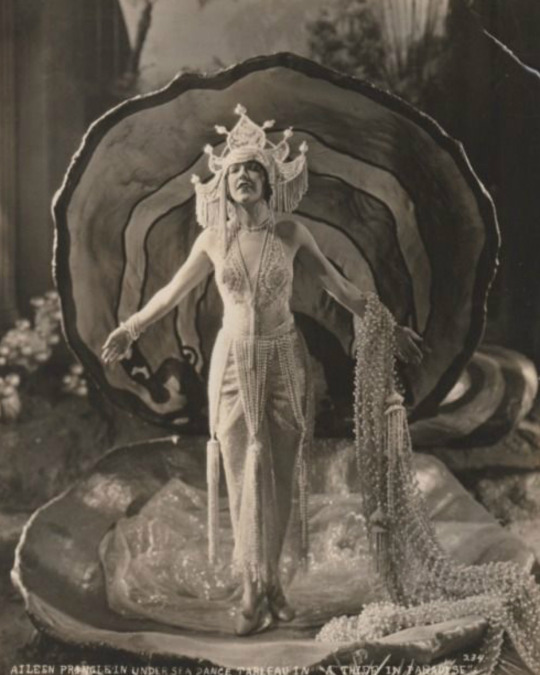

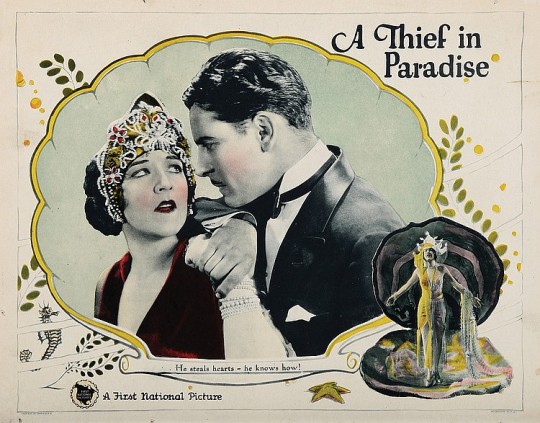
Direction: George Fitzmaurice
Scenario: Frances Marion (learn more at the Women Film Pioneers Project)
Original Novel: Leonard Merrick’s “The Worldlings”
Camera: Arthur C. Miller
Set Design: Anton Grote
Studio: Goldwyn (production) & First National (distribution)
Performers: Doris Kenyon, Ronald Colman, Aileen Pringle, Claude Gillingwater, Alec B. Francis, John Patrick, Charles Youree, Etta Lee, Lon Poff
Polo Players: Nita Cavalier, Virginia Jolly, Martha Wing
Premiere: 25 January 1925 at the Strand, New York
Status: presumed lost, save for a trailer
Length: 7, 231-7,251 feet, or roughly 71 minutes. (8 reels)
Synopsis (synthesized from magazine summaries of the plot):
While pearl diving off the coast of a remote South Seas island, Philip Jardine (Youree) and Maurice Blake (Colman) have a vicious fight underwater over the possession of a valuable pearl. In the struggle, Jardine is cut and subsequently attacked by a shark and killed. Blake manages to escape to shore.

Aileen Pringle & Ronald Colman in A Thief in Paradise from Exhibitors Trade Review, 10 January 1925
Rosa Carmino (Pringle), Jardine’s common-law wife, reveals to Blake that Jardine came from a wealthy family back in the United States. A letter and money has arrived to carry Jardine back home to San Francisco to reunite with his long-estranged father (Gillingwater). Carmino convinces Blake to assume Jardine’s identity. Blake Has doubts, but the promise of a fresh start leads him to accept the proposition. Blake and Carmino travel together to California.
The deception is successful and Blake begins running in high society where he meets Helen Saville (Kenyon). Saville is the daughter of a Bishop (Francis), who happens to be the elder Jardine’s best friend. The old men are keen on the relationship, but Blake is held back by guilt over his deception. Additionally, as part of the identity theft scheme, Blake is bankrolling Carmino’s luxurious bohemian lifestyle.
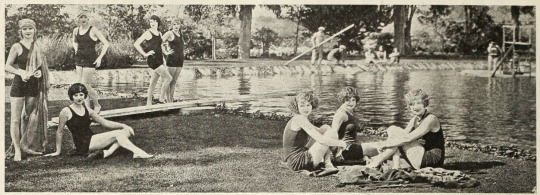
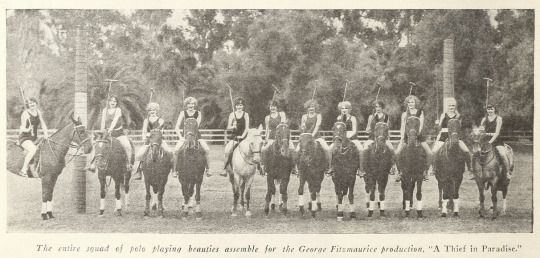
Top: Bathing Beauties in A Thief in Paradise from Exhibitors Trade Review, 10 January 1925 | Bottom: Bathing Beauties in A Thief in Paradise from Screenland, February 1925
On the grounds of the Jardine estate, a bevy of bathing beauties decide to put on a polo match—blondes vs. brunettes. Saville is also spending the day riding, and her horse gets startled and bolts headlong toward a cliff. Blake springs into action and manages to save Saville at the last moment. Overwhelmed by the situation, Blake confesses his love for Saville. The exchange is overheard by Jardine and the Bishop.

Alec Francis, Claude Gillingwater, Doris Kenyon, & Ronald Colman in A Thief in Paradise from Exhibitors Trade Review, 10 January 1925
Jardine throws an extravagant party where he announces the youngsters’ engagement. Unfortunately, Carmino is one of the entertainers hired for the party. Carmino performs a dramatic under-the-sea dance number that creatively retells the story of Blake and Jardine’s underwater battle. As it turns out, Carmino is in love with Blake and she is unpleasantly surprised with the engagement announcement. Carmino threatens to expose Blake. Blake attempts to pay her off.

Under-the-water dance sequence in A Thief in Paradise from Exhibitors Trade Review, 10 January 1925
Blake and Saville are married and head off via airplane to Del Monte Beach for their honeymoon. Blake is overwhelmed with guilt and is working up the courage to make a full confession to Saville. Unbeknownst to Blake, Carmino has followed the couple. Carmino goes straight to Saville, but rather than revealing the deception, she claims that she is Blake’s mistress and that he has been keeping her. Carmino uses the pay-off check Blake gave her as evidence. Saville is heartbroken and immediately returns home.
Blake follows Saville back to San Francisco, where he confesses to both the elder Jardine and Saville. The old man’s heart is also broken as he has accepted Blake as his son and loved him as such. Blake is despondent and shoots himself.
Miraculously, Blake survives and Saville has chosen to stand by him and nurse him back to health. Jardine has accepted Blake as his true son, forgiving the deception. Carmino returns home.

Miscellaneous stills from A Thief in Paradise from Motion Picture News, 26 December 1925 [L to R: John Patrick, Aileen Pringle, Ronald Colman, Pringle, Pringle, Etta Lee, Colman, Doris Kenyon, Kenyon, Colman, Pringle]
Additional sequences featured in the film (but I’m not sure where they fit in the continuity):
Another dance sequence by Pringle as Carmino staged in her studio apartment
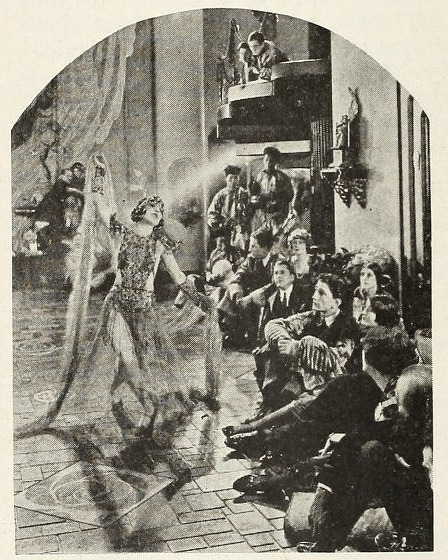
Aileen Pringle in A Thief in Paradise from Exhibitors Trade Review, 10 January 1925
The Bishop Saville and Jardine play chess and the Bishops cheats, is caught by Jardine
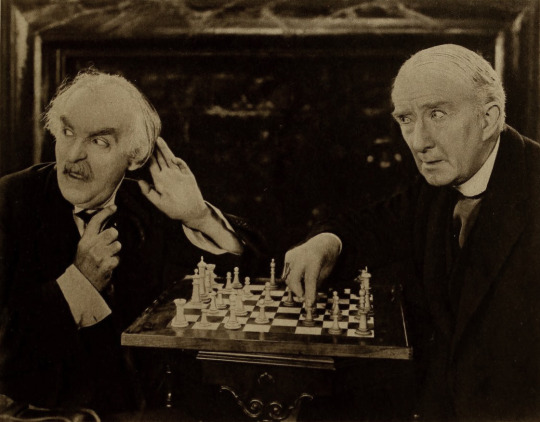
Claude Gillingwater & Alec Francis in A Thief in Paradise from Motion Picture Magazine, March 1925
Four old men are left to care for a baby and are at a loss
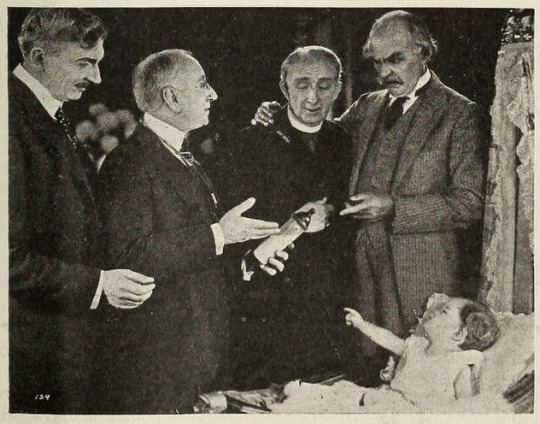
Four old men (Alec B. Francis & Claude Gillingwater to right) in A Thief in Paradise from Exhibitors Trade Review, 10 January 1925
A snafu regarding a taxicab losing its wheel, driver is upset
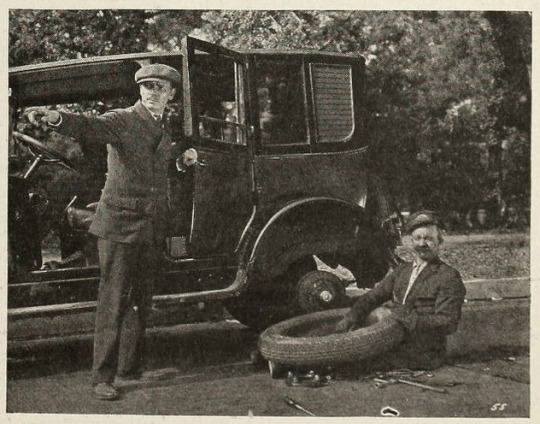
Taxicab snafu in A Thief in Paradise from Exhibitors Trade Review, 10 January 1925
---
Points of Interest:
Contemporary blurb that describes the under-the-sea dance sequence in more detail:
“By a combination of photography and set design, gigantic fish swim about among the coral trees and huge sea shells. Even the human participants in the under-sea dance make their entrance as divers swimming down from the surface to the immense shell on the ocean’s floor which serves as the hiding place of the stellar feminine dancer who is clad in a symbolic costume of pearls.
“In order to enhance the brilliancy of the picture, the entire set, including coral, shells and floor of the sea, was finished in bright silver and the costumes of the dancers were made entirely of especially constructed luminous silver and gold cloth. Even the natural flicker of light and shadow which characterizes scenes actually filmed under water was reproduced by the technicians.
“The marine dance tableau constitutes a play within a play in “A Thief in Paradise.” It is the entertainment provided by the host at a lavish engagement party given in honor of two of the principals and also has an important dramatic value in developing one of the many dramatic moments of the story.”
- Moving Picture World, 10 January 1925
Based on some of the stills, I think it’s possible that Aileen Pringle may have had a double for this dance sequence, but no other dancers are credited. There is also no credit I could find for a choreographer.
The amount of pure spectacle packed into a mere seventy-one minutes is astounding to me! Knowing how skilled Frances Marion was as a scenarist, I don’t doubt that A Thief in Paradise managed to deliver plot just as well as it (according to contemporary reviews) delivered the spectacle. Film historians have been working for years to restore Marion’s rightful place as a crucial figure in American film history, so examples of her work being lost sting just that much more.
Despite the fact that A Thief in Paradise was a huge success and a top box-office draw of 1925, comparatively little digitized material exists online. Most notably absent are stills from the South Seas portion of the film.
This Ronald Colman fan website has some screenshots from the extant trailer as well as a digitized copy of a program from ATiP’s German release.
Hawaiian actress Etta Lee also appears in this film as Carmino’s maid. I ended up going down a bit of a rabbit hole reading about Lee and will probably end up doing a spin-off of this post about her career. You may recognize Lee from her roles in The Untameable (1923), The Toll of the Sea (1922), or The Thief of Baghdad (1924)
☕Appreciate my work? Buy me a coffee! ☕
---
Transcribed Sources & Annotations over on the WMM Blog!
#1920s#1925#Ronald Colman#Aileen Pringle#Doris Kenyon#Etta Lee#george fitzmaurice#silent cinema#silent film#lost film#classic movies#classicfilmblr#american film#Goldwyn#silent movies#film history#history
18 notes
·
View notes
Text
I always see people talk about how Coppola’s 1992 adaptation is the only one with Quincey-- UNTRUE. 1977′s Dracula, directed by Philip Saville, while not having Arthur, DOES have Quincey. And he is a joy. There’s a lot of changes, of course. He is Quincey P. Holmwood, and he’s Lucy’s fiancé. I haven’t watched it in a while, but his accent is a hoot, and when he talks he is just so stereotypically Southern, I love it. Every line is yelled like he’s at a Texas rodeo.
He got the American embassy?? To track down Jonathan for Mina’s sake?? Lucy, your husband is a keeper.
Other than keeping the cowboy, the movie also just does a nice job of portraying the story without adding fluff about Dracula’s secret untold emo past.
#people were talking about this movie a while ago saying it's the most accurate#dracula#dracula daily#dracula 1977#Quincey Morris#quincey p morris
105 notes
·
View notes
Text















the buccaneers episode 1 "invasion" (1995) dir. philip saville
3 notes
·
View notes
Text

Robert Powell-Shirley Knight "Juegos íntimos" (Secrets) 1971, de Philip Saville.
6 notes
·
View notes
Text
2024 olympians representing non-birth nation by country part 1
USA: Zhang Beiwen, badminton (China); Miles Chamley-Watson, fencing (U.K.); Luca Cupido, water polo (Italy); Jaime Czarkowski, swimming (Canada); Joel Embiid, basketball (Cameroon); Grant Fisher, athletics (Canada); Margherita Guzzi-Vincenti, fencing (Italy); Colin Heathcock, fencing (China); Madison Hughes, Rugby (U.K.); Kirsten Kasper, triathlon (Canada); Weini Kelati-Frezghi, athletics (Eritrea), Leonard Korir, athletics (Kenya); Maria Laborde, judo (Cuba); Lucas Lacamp, rugby (China); Catarina Macário, Soccer (Brazil); Boyd Martin, equestrian (Australia); Abdi Nur, athletics (Somalia); Marcus Orlob, equestrian (Germany); Steffen Peters, equestrian (Germany); Ruby Remati, swimming (Australia); Jovana Sekulic, water polo (Serbia); Aliaksei Shostak, gymnastics (Belarus) & Kieran Smith, swimming (Australia)
Afghanistan: Kamia Yousufi, athletics (Iran)
Albania: Zelimkhan Abakarov, wrestling (Russia); Islam Dudaev, wrestling (Russia) & Chermen Valiev, wrestling (Russia)
Algeria: Saoussen Boudiaf, fencing (France); Mehdi Bouloussa, table tennis (France); Carole Bouzidi, canoeing (France); Zohra Kehli, fencing (France); Koceila Mammeri, badminton (France); Tanina Mammeri, badminton (France) & Kaylia Nemour, gymnastics (France)
Angola: Albertina Kassoma, handball (Cape Verde)
Antigua & Barbuda: Tiger Tyson, sailing (New Zealand)
Argentina: José Larocca; Jr., equestrian (Switzerland); Federico Redondo, soccer (Spain) & Rocco Ríos-Novo, soccer (U.S.A.)
Aruba: Philip Elhage, shooting (Curaçao) & Just Van Aanholt, sailing (The Netherlands)
Australia: Mariafe Artacho-Del Solar, volleyball (Peru); Kelsey-Lee Barber, athletics (South Africa); Oliver Bleddyn, cycling (U.K.); Nagmeldin Bol, athletics (Sudan); Tim Brand, field hockey (The Netherlands); Rhiannan Brown, sailing (Thailand); Carolyn Buckle, swimming (Singapore); Bronte Campbell, swimming (Malawi); Eileen Cikimatana, weightlifting (Fiji); Bronwyn Cox, rowing (U.K.); Joseph Deng, athletics (Kenya); Sinead Diver, athletics (Ireland); Dominique Du Toit, rugby (Zimbabwe); Matthew Ebden, tennis (South Africa); Thaisa Erwin, equestrian (U.K.); Sergei Evglevski, shooting (Belarus); Jessica Fox, canoeing (France); Noemie Fox, canoeing (France); Dr. Elena Galiabovitch, shooting (Belarus); Raphaelle Gauthier, swimming (France); Daniel Golubovic, athletics (U.S.A.); Kathi Haecker, judo (Germany); Danijela Jackovich, water polo (U.S.A.); Min Jee, table tennis (South Korea); Nia Jerwood, sailing (U.K.); Maddison Keeney, diving (New Zealand); Alexandra Kiroi-Bogatyreva, gymnastics (New Zealand); Amy Lawton, field hockey (U.K.); Alysia Lefau-Fakaosilea, rugby (New Zealand); Kyle Lee, swimming (Zimbabwe); Mackenzie Little, athletics (U.S.A.); Oceana Mackenzie, climbing (Germany); Ezi Magbegor, basketball (New Zealand); Setyana Mapasa, badminton (Indonesia); Miloš Maksimović, water polo (Serbia); Jacob Merčep, water polo (Croatia); Rowena Meredith, rowing (U.K.); Samantha Morton, rowing (China); Thomas Neill, swimming (China); Conor Nicholas, sailing (Malaysia); Georgii Okorokov, wrestling (Russia); Keegan Palmer, skateboarding (U.S.A.); Duop Reath, basketball (South Sudan); Yual Reath, athletics (South Sudan); Matthew Richardson, cycling (U.K.); Daria Saville, tennis (Russia); Breanna Scott, gymnastics (Singapore); Declan Tingay, athletics (U.S.A.); Ajla Tomljanović, tennis (Croatia); Josh Turner, rugby (New Zealand); Jean Van Der Westhuyzen, canoeing (South Africa); Pierre Van Der Westhuyzen, canoeing (South Africa); Milena Waldmann, swimming (Uzbekistan); Samantha Whitcomb, basketball (U.S.A.) & Joshua Yong, swimming (Brunei)
Austria: Lorena Abicht, sailing (Germany); Anna-Maria Alexandri, swimming (Greece); Eirini-Marina Alexandri, swimming (Greece); Wachid Borchashvili, judo (Russia); Enzo Diessl, athletics (Argentina); Max Kühner, equestrian (Germany); Lukas Mähr, sailing (Germany); Lubjana Piovesana, judo (U.K.); Sofia Polcanova, table tennis (Moldova) & Elisabeth Straka, archery (Germany)
#Sports#National Teams#U.S.A.#U.S.#Fights#Canada#Races#Somalia#Eritrea#Basketball#Cameroon#Animals#Germany#Belarus#Australia#Serbia#Italy#Albania#Russia#Algeria#France#Boats#Angola#Cape Verde#Antigua & Barbuda#New Zealand#Argentina#Switzerland#Soccer#Spain
4 notes
·
View notes